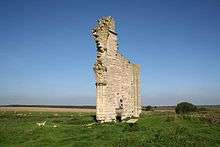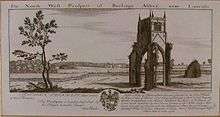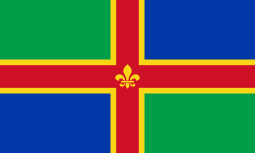Barlings Abbey

Barlings Abbey, Lincolnshire, was a Premonstratensian monastery in England, founded in 1154.
History

Its founder was Ralph de Haye,[1] son of the constable of Lincoln Castle, and lord of Burwell and Carlton. It was first established at Barlings Grange but was soon moved to its present site, previously called Oxeney[2] in Lawress wapentake of the West Riding of the Parts of Lindsey.[3]
By the mid-14th century the canons are known to have been in considerable financial trouble and even by 1412 when there were twenty-seven in residence, they were maintained with difficulty due to continued poverty and debt. By 1497 the situation had improved with the abbot praised for his administration and the monastery remarked to be in a good state. Sir John Rochford (or de Rochefort) (c.1355-1410) constable of the Bishop of Ely's castle at Wisbech, Cambs and his wife Alice (daughter of Sir Hugh de Hastings) are believed to have been buried at the abbey (he left a will dated 20 October 1410, proved 14 Dec. 1410, requesting burial at Barlings Abbey, Lincolnshire, next to his late wife, Alice). see Blomefield, Hist. of Norfolk 4 (1775): 712 (wife identified as Alice, daughter of Sir Hugh de Hastings).
In 1537, during the Dissolution of the Monasteries, the abbey became involved in the uprisings against this act and the abbot, Matthew Mackarel,[4] and six of the canons were subsequently executed. The abbey was closed and the remainder of the canons expelled with little compensation due to the activities of their condemned brethren, with the property then passing to the Duke of Suffolk.
Post-Dissolution
Sections of the cloister range stood until 1730 as did the impressive central tower of the church which finally collapsed in 1757. Its appearance was recorded in an engraving by Samuel Buck in 1726. Now only earthworks and one large chunk of nave walling remain and are accessible to the public.
The main building outside the monastic church has been interpreted as a detached monastic household such as the abbot's lodging. This building was reformed as a post-Dissolution secular residence of Charles Brandon, Duke of Suffolk, who used it as a vice-regal palace. Brandon was King Henry VIII's vice-regent in Lincolnshire in the wake of the Lincolnshire Rising.[5]
References
- 'Houses of Premonstratensian canons: The abbey of Barlings', A History of the County of Lincoln: Volume 2 (1906), pp. 202–05.
- Anthony New. 'A Guide to the Abbeys of England And Wales', p48-49. Constable.
Notes
- ↑
 Herbermann, Charles, ed. (1913). "Abbey of Barlings". Catholic Encyclopedia. New York: Robert Appleton Company.
Herbermann, Charles, ed. (1913). "Abbey of Barlings". Catholic Encyclopedia. New York: Robert Appleton Company. - ↑ Lincolnshire Topographical, Historical, and Descriptive, by W. Marrat
- ↑ Open Domesday Map: Barlings
- ↑ Dictionary of National Biography
- ↑ Everson, P and Stocker, D 2003. ‘The archaeology of vice-regality: Charles Brandon’s brief rule in Lincolnshire’ in eds David Gaimster and Roberta Gilchrist, The Archaeology of Reformation c 1480-1580, Society for Post-Medieval Archaeology monograph 1, 145-58.
External links
| Wikimedia Commons has media related to Barlings Abbey. |
Coordinates: 53°14′52″N 0°22′07″W / 53.2479°N 0.3685°W

